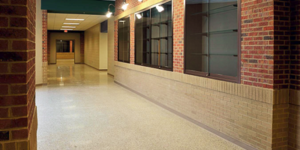At first, everything seemed perfect as my salesman and I finished setting up our booth for the annual home design and remodeling show in Visalia, Calif. Our exhibit location was ideal, our stamp and stain samples strategically located. The weekend crowd was near maximum capacity and everything seemed ripe for booking plenty of new accounts.
We didn’t worry when the first few folks asked if our company offered a stampable overlay service — we didn’t, so we directed them to a competing contractor located a few aisles away. But by the time a dozen homeowners asked for a service we didn’t offer, it became painfully apparent the local decorative market had changed beyond our staining and stamping services.
I’m not fond of turning away work, but this is exactly what my salesman and I repeatedly did, because saying “No, I’m sorry but we don’t offer a stampable overlay” was better than the risk of performing a service my crew had yet to master.
Over the last couple of decades I’ve had to say no to billionaires, movie producers, neighbors and relatives. No one likes to be told no, because “no” is the opposite of whatever it is they’re asking for.
However, telling a prospective or current customer no can be the most profitable task a contractor performs. The art of saying no — without upsetting a client — is one that will eliminate sleepless nights and anxious days, trust me.
I’ve listed the top three reasons a decorative contractor should say no. After that, I will offer an example of how “no” can take your decorative concrete business to a new level.
Red-flag customers
You know the ones. They are potential customers who will not be happy regardless of the discount, regardless of the quality. They are complicated souls who always have something to complain about. Sometimes they’re perfectionists, sometimes they are the opposite. The end result is almost always conflict and the net result is rarely profitable for the contractor. They’re the customers who should have heard “no” long before trouble begins.
Decorative concrete is not for everyone. Some folks are not a good fit for our industry, but have yet to realize this fact. They must be told no.
Some buyers buy in haste. They are busy and don’t have time for samples, colors, designs, meetings, education or any other front-end work that is such a necessary part of the decorative concrete industry. They, too, should be told no.
Sometimes “no” is really a stern way to take control of a project. It forces a customer to slow down and focus on making a decision that only they can make. I recall a time or two when we actually pulled off projects by saying no to moving forward until the owner made a crucial decision or we found common ground. Not saying no meant having to deal with a compounding problem at job’s end. My advice is to never let conflict go. Always find common ground, even if this means saying, “Sorry, but no.”
Lack of experience
I’m sorry to say this, but your skill level, in some fashion, is subpar compared to other concrete artisans. Don’t take it personally — even the most skilled decorative artist is no match for some aspect of your decorative skill.
On top of that, our industry is infinite and constantly changing whether we like to admit it or not. This is neither good nor bad. It’s just the evolutionary process. Decorative concrete is in a never-ending flux of improvement and change, and eventually it will move beyond our level of skill.
My point is, none of us know everything about decorative concrete.
This is why you must learn to say no when a customer asks for something you’re not skilled in. In truth, it’s not fair to your crew or customer to tackle a decorative project beyond your area of expertise. I receive emails and calls regularly from contractors who wandered outside their area of expertise and are now searching for an easy fix. They should have said no instead.
A high-quality decorative concrete project is a merger between the right product and skillful hands. Take either from the equation and the result is not good. It takes time to build expertise, and it takes time to find the best products too. There are hundreds of examples of subpar decorative installations in your area alone that do nothing good for our industry. They only exist because someone failed to say no.
Lack of trained manpower
Most decorative concrete installations are timing-sensitive. This means you have a limited window to color, stain, smooth, stamp, polish or trowel. If this window closes before your work is complete, the result can be costly.
Technology and innovation cannot replace the hands of a skilled artisan who can complete work in a timely fashion. It comes down to skill above all else.
Mastering the many facets of decorative artistry takes years, maybe decades. Understanding your crew’s limitations is a vital part of building a solid reputation of quality work. Saying no to projects beyond the capabilities of your crew is not only recommended but prudent.
Taking your business to the next level
Sometime in the near future you will have a customer request a type of decorative concrete installation you’re not 100 percent comfortable performing. Instead of saying no, why not use this opportunity to advance your skill by bringing in the assistance of someone who specializes in this unfamiliar request?
I recommend being honest with your customer by explaining why, or how, their project is unique and that you would like to bring in outside help at no extra cost. This offers a perfect opportunity for you to advance your skill while satisfying your customer’s request.
Manufacturers and materials suppliers can offer you the names of qualified individuals who can assist with this type of teaming. Feel free to email me for a list of possible candidates too.















